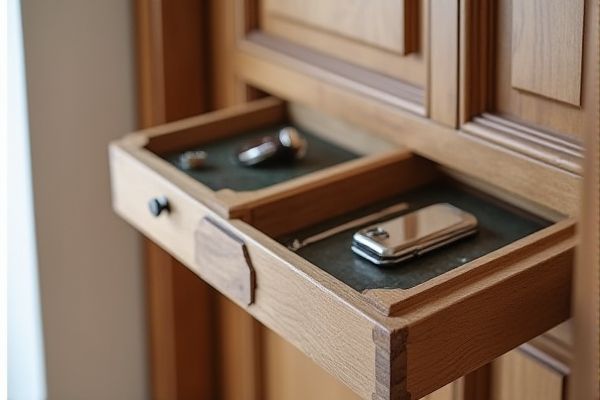
A key storage box offers secure, often lockable space for organizing and protecting your keys, while a key holder tray provides an open, easily accessible surface for everyday use. Explore the rest of the article to determine which option best suits your needs and lifestyle.
Table of Comparison
| Feature | Key Storage Box | Key Holder Tray |
|---|---|---|
| Purpose | Securely store keys, often lockable | Organize and display keys for quick access |
| Security | High - typically lockable, protects keys | Low - open design, no locking mechanism |
| Material | Metal, plastic, or wood with sturdy construction | Wood, plastic, or metal, lightweight construction |
| Capacity | Varies; usually holds multiple keys or sets | Limited; holds keys laid out on tray |
| Portability | Often portable but designed for stationary use | Portable and easy to move |
| Installation | May require wall mounting or placement on desk | No installation needed; placed anywhere |
| Visibility | Keys concealed inside the box | Keys clearly visible and accessible |
Overview of Key Storage Solutions
Key storage boxes provide secure, lockable compartments designed to protect keys from theft and unauthorized access, ideal for both residential and commercial use. Key holder trays offer a convenient, open design for organizing and quickly accessing frequently used keys in home or office settings. Choosing between these solutions depends on security needs and accessibility preferences.
What is a Key Storage Box?
A key storage box is a secure container designed to store multiple keys in an organized and protected manner, often featuring a lock or combination access for enhanced security. These boxes are typically constructed from durable materials like metal or heavy-duty plastic to prevent unauthorized access and ensure keys remain safe from theft or misplacement. Unlike a key holder tray, which provides easy access but limited security, a key storage box prioritizes safeguarding keys while maintaining orderly storage.
What is a Key Holder Tray?
A key holder tray is a compact, decorative container designed to organize and store keys in a convenient, accessible location such as an entryway table or countertop. Unlike a key storage box, which often features a lock for security, key holder trays prioritize ease of use and visibility, making it simple to grab or drop keys quickly. These trays come in various materials like wood, metal, or ceramic, blending functionality with home decor.
Design and Structure Comparison
A key storage box typically features a secure, enclosed design with compartments or hooks inside to protect keys from loss and damage, often including a lock for added security. In contrast, a key holder tray is open and shallow, designed for quick access and easy organization of keys on a flat surface without secure enclosure. The box prioritizes protection and locking capability, while the tray emphasizes convenience and visibility.
Security Features: Box vs Tray
A key storage box offers enhanced security features such as lockable mechanisms, tamper-resistant materials, and weatherproof designs to protect keys against unauthorized access and environmental damage. In contrast, a key holder tray typically provides minimal security, serving more as an organized surface without locks or protective enclosures. Choosing a keyed box is essential for securing sensitive keys, while a tray suits low-risk environments prioritizing easy access over security.
Capacity and Organization
Key storage boxes offer enhanced capacity with multiple compartments designed to securely store a large number of keys, making them ideal for households or businesses with extensive key collections. Key holder trays provide a more compact and open design suitable for organizing a smaller set of everyday keys, offering quick access and visibility. Both solutions optimize key management, but storage boxes prioritize secure, systematic organization, whereas trays emphasize convenience and simplicity.
Ease of Use and Accessibility
A key storage box offers secure, organized key management with limited access, ideal for safeguarding multiple keys but may require a key or code to open, slightly reducing immediate accessibility. In contrast, a key holder tray provides quick and easy access by keeping keys visible and within reach, perfect for daily convenience but less secure for sensitive keys. Your choice depends on balancing the need for security with the priority of effortless access based on your usage context.
Ideal Use Cases for Each Option
A key storage box offers secure and organized storage for multiple keys, making it ideal for offices, rental properties, or households requiring controlled access and enhanced security. A key holder tray suits entryways or countertops where frequent access and quick organization of daily-use keys are necessary without the need for locking mechanisms. Choosing between the two depends on the importance of security versus convenience and ease of access.
Aesthetic and Space Considerations
A key storage box offers a sleek, enclosed design that keeps your keys neatly hidden, enhancing a minimalist aesthetic and reducing visual clutter. In contrast, a key holder tray provides easy access with an open layout, ideal for showcasing stylish keys or accessories but requiring more surface space. Your choice depends on whether you prioritize discreet storage or decorative display in limited or spacious areas.
Choosing the Right Key Organizer for You
Selecting the right key organizer depends on your lifestyle and space requirements. A key storage box offers secure, enclosed protection for multiple keys, ideal for homes or offices needing organization and safety. Your choice between a key holder tray and a key storage box hinges on whether you prioritize easy access or secure storage for your keys.
 homyna.com
homyna.com